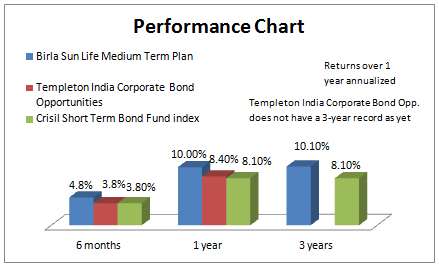Looking Beyond Interest Rate Movements
Investors willing to take relatively higher risks within the debt category can consider exposure to ‘credit opportunities’ funds; or funds that seek to gain from opportunities in the corporate credit space.
We think Birla Sun Life Medium Term Plan and Templeton India Corporate Bond Opportunities are well-placed to tap the opportunities in the bond space. While Templeton India Corporate Bond Opportunities is yet to complete 2 years, Birla Sun Life Medium Term delivered over 10% annual returns over the last 2 and 3 years.
These funds hold the potential to deliver longer periods of higher returns than the returns one can gain from any rate cuts, as and when it happens. The risks attached, of course, are much higher than duration funds.
Currently, weak corporate performance has meant that there are plenty of temporarily mispriced credit opportunities. There are also companies that pay a high yield to get funding in the short term. This, of course, requires great acumen on the part of the fund manager in picking ‘quality’ opportunities.
The spread between corporate bonds (with AA-rating) and government securities, especially in the less than 3 years horizon, at well over 100 basis points, provides enough scope for gain when the economic situation does change and the spread shrinks (when the corporate credit situation improves).
While we may not witness any improvement in the corporate credit situation in the near term, we are probably heading there, with the funding situation likely to improve in perhaps a quarter from now. Yields have already seen a fall in the last 2-3 months.
Fund Strategy
Both Birla Sun Life Medium Term Plan and Templeton India Corporate Bond Opportunities seek to keep their portfolio maturity under 3 years. They do not actively play the interest rate risk although they may benefit from any rate movements within the tenure in which they seek to hold debt instruments. Hence, these funds may not react as sharply as pure gilt funds when yields move upward (when started in the event of a rate hike).
These funds operate in several ways within the corporate debt market. One, they may simply capitalise on the high yields prevailing in corporate bonds during high-rate scenarios. They may either hold such instruments till maturity and get the entire interest accrual, or alternatively, benefit from any compression in corporate bond spreads (spread is the difference in yields between a corporate bond and a government security of similar tenure).
They may also hold instruments whose credit ratings are a notch or two lower than the top rating and gain from capital appreciation that comes from any improvement in rating. Often times, to reduce the trading or price risk that comes with non-AAA rated instruments; these schemes may hold them till maturity. This way, price volatility, besides illiquid conditions, can be avoided.
It is for this reason that these funds also tend to keep the average maturity within 3 years. Currently, while it is well under 2 years for Birla Sun life Medium Term Plan, it is about 2.64 years for Templeton India Corporate Bond Opportunities.
Suitability
One, investors need to have a high risk appetite within the realms of the debt space. When we say this, we mean that investors should be willing to take volatility in their NAVs. These funds have fallen by up to 1.7% in a single day on July 16, 2013, when liquidity tightening measures were announced by the RBI.
Two, investors need to have a horizon that is not less than 3 years if they wish to invest in this fund. They should strictly use ultra short-term or short-term debt funds for their financial needs up to 2 years and not venture in to these funds unless they have a longer time frame.
Stiff exit loads – 2 years for Birla Sun Life Medium Term Plan and 2.5 years for Templeton India Corporate Bond Opportunities – go to suggest that the schemes discourage outflows in the short term and require a buy and hold strategy. Discouraging outflows will help the schemes to hold the instruments till maturity, wherever warranted, thus significantly reducing trade/price risks in the market.
Three, these funds should not form the core of any investor’s portfolio. If you are seeking to enhance your portfolio returns with un-rated (or rating not disclosed) fixed deposits of companies, you may be better off holding these schemes, as the fund manager will do sufficient due diligence on your behalf.
The basket, which will be a mix of AAA- and lower rated instruments will also lend diversification than holding a single corporate fixed deposit.
Birla Sun Life Medium Term Plan is more suitable for investors willing to go for a higher risk-return proposition. Templeton India Corporate Bond Opportunities’ portfolio, on the other hand, appears a little less aggressive in terms of the nature of instruments it holds.
Portfolio and Performance

Birla Sun Life Medium Term Plan has a portfolio with about 55% invested in AA-rated instruments or lower. Still, it has thus far managed to gain from the higher yields in these instruments without any risk of default. It has managed this by either going for very short-term maturities where the credit risk is low or building in covenants in some instruments to safeguard itself. The fund beat its benchmark on all occasions on a rolling 1-year return basis in the last 3 years.
Templeton India Corporate Bond Opportunities has not disclosed its average credit rating but a look at its portfolio suggests that it may have fewer instruments below AA. It also has about 12% in money market instruments, mostly banks.
Both the funds have dipped in to negative territory on 28 sessions (daily returns) since July, but so has their benchmark, Crisil Short-Term Bond Fund Index.








well done.
well done.
Very nice analysis
Very nice analysis